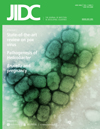Detection of pbp2b and ermB genes in clinical isolates of Streptococcus pneumoniae
DOI:
https://doi.org/10.3855/jidc.262Keywords:
penicillin, macrolide, Streptococcus pneumoniae, Real-Time PCR, antibiotic resistance, pneumolysinAbstract
Background: Streptococcus pneumoniae is a major human pathogen. The emergence of penicillin resistant strains since the 1970s has been life threatening and the evolution of the bacteria have enabled itself to develop resistance to many other antibiotics such as the macrolides and the fluoroquinolones. This study aims to characterize S. pneumoniae isolates for the presence of penicillin and macrolide resistance genes. Methodology: One hundred and twenty clinical isolates of S. pneumoniae were obtained from patients of University Malaya Medical Centre (UMMC). The strains were screened using a multiplex real-time PCR method for the presence of alterations in the genes encoding the penicillin binding proteins: pbp2b, macrolide resistance determinant ermB and the pneumolysin gene, ply. Dual-labelled Taqman probes were used in the real-time detection method comprising three different genes labeled with individual fluorophores at different wavelengths. One hundred and twenty isolates from bacterial cultures and isolates directly from blood cultures samples were analyzed using this assay. Results: A multiplex PCR comprising the antibiotic resistance genes, ermB and and pneumolysin gene (ply), a S. pneumoniae species specific gene, was developed to characterize strains of S. pneumoniae. Out of the 120 pneumococcal isolates, 58 strains were categorized as Penicillin Sensitive Streptococcus pneumoniae (PSSP), 36 as Penicillin Intermediate Streptococcus pneumoniae (PISP) and 26 as Penicillin Resistant Streptococcus pneumoniae (PRSP). All the 58 PSSP strains harboured the pbp2b gene while the 36 PISP and 26 PRSP strains did not harbour this gene, thus suggesting reduced susceptibility to penicillin. Resistance to erythromycin was observed in 47 of the pneumococcal strains while 15 and 58 were intermediate and sensitive to this drug respectively. Susceptibility testing to other β-lactams (CTX and CRO) also showed reduced susceptibility among the strains within the PISP and PRSP groups but most PSSP strains were sensitive to other antibiotics. Conclusion: The characterization of pneumococcal isolates for penicillin and erythromycin resistance genes could be useful to predict the susceptibility of these isolates to other antibiotics, especially β-lactams drugs. We have developed an assay with a shorter turnaround time to determine the species and resistance profile of Streptococcus pneumoniae with respect to penicillin and macrolides using the Real Time PCR format with fluorescent labeled Taqman probes, hence facilitating earlier and more definitive antimicrobial therapy which may lead to better patient management.Downloads
Published
2008-06-01
How to Cite
1.
Kumari N, Navaratnam P, Sekaran SD (2008) Detection of pbp2b and ermB genes in clinical isolates of Streptococcus pneumoniae. J Infect Dev Ctries 2:193–199. doi: 10.3855/jidc.262
Issue
Section
Original Articles
License
Authors who publish with this journal agree to the following terms:
- Authors retain copyright and grant the journal right of first publication with the work simultaneously licensed under a Creative Commons Attribution License that allows others to share the work with an acknowledgement of the work's authorship and initial publication in this journal.
- Authors are able to enter into separate, additional contractual arrangements for the non-exclusive distribution of the journal's published version of the work (e.g., post it to an institutional repository or publish it in a book), with an acknowledgement of its initial publication in this journal.
- Authors are permitted and encouraged to post their work online (e.g., in institutional repositories or on their website) prior to and during the submission process, as it can lead to productive exchanges, as well as earlier and greater citation of published work (See The Effect of Open Access).








